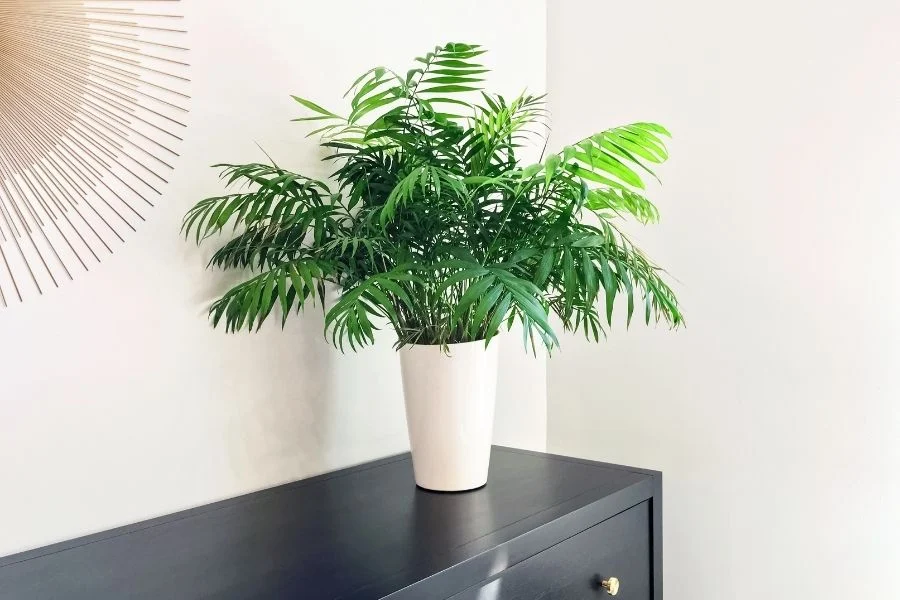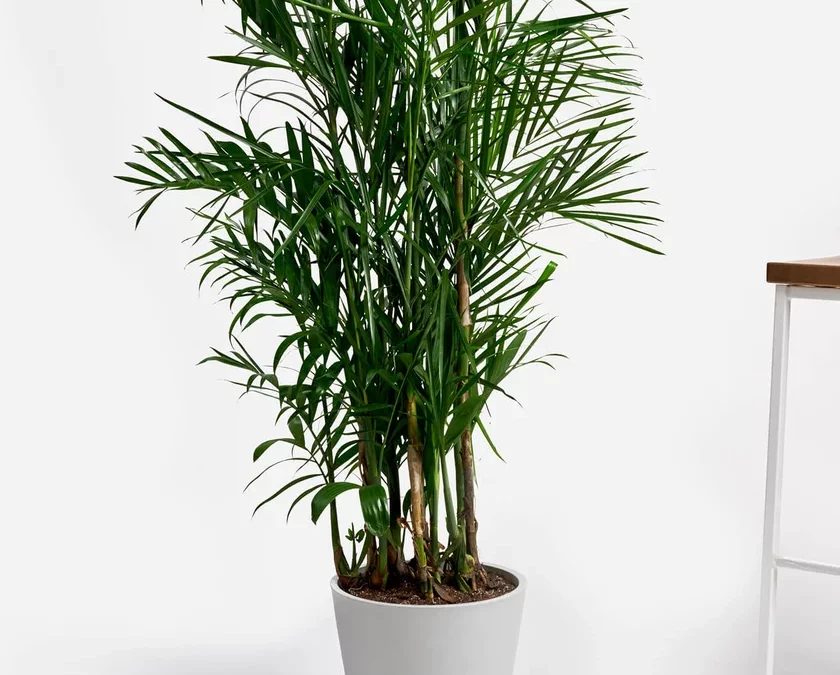Bamboo palms are one of those houseplants that instantly make a room feel calmer and more tropical. The good news? With the right light, watering, and soil, bamboo palm care is very beginner-friendly – no greenhouse required.
If you’re choosing bamboo palm as part of a “clean air” setup, it works nicely alongside the plants in the Indoor Plants for Air Purification guide, which covers more options for fresher indoor air.
Contents
- 0.1 Getting to Know the Bamboo Palm
- 0.2 Best Light and Placement for Bamboo Palm Care
- 0.3 Soil and Potting Mix for Bamboo Palms
- 0.4 Watering Routine for Healthy Bamboo Palm Care
- 0.5 Humidity, Temperature and General Comfort
- 0.6 Feeding and Repotting Your Bamboo Palm
- 0.7 Common Bamboo Palm Problems (and How to Fix Them)
- 0.8 FAQs About Bamboo Palm Care
- 0.9 Final Thoughts on Bamboo Palm Care
- 0.10 Related Articles
- 1 Discover Indoor Plants That Boost Your Mood
Getting to Know the Bamboo Palm
Bamboo palm (usually Chamaedorea seifrizii) is a clumping palm with slender, cane-like stems and soft, feathery fronds. It stays reasonably compact indoors and is often recommended as a good air-purifying plant.
For easy bamboo palm care, it helps to remember:
It prefers bright, indirect light rather than harsh direct sun.
It likes even moisture, not bone-dry soil or soggy roots.
It enjoys moderate humidity, similar to what you’d find in a comfortable home.
Once you give your bamboo palm those basics, it tends to grow steadily without demanding constant attention.

Best Light and Placement for Bamboo Palm Care
Light is one of the most important parts of bamboo palm care. Too dark, and it becomes thin and leggy; too much sun, and the leaves scorch.
Ideal spots:
A bright room with filtered or indirect light
A metre or so back from a south- or west-facing window
Near an east-facing window that gets gentle morning sun
Try to avoid:
Deep, gloomy corners with no natural light
Right against hot glass in midsummer
Constant cold draughts from doors or windows
If you only have slightly dimmer rooms, bamboo palm can still cope – just expect slower growth and watch for stretched, pale fronds as a sign it wants a bit more light.
Soil and Potting Mix for Bamboo Palms
Good soil is the foundation of easy bamboo palm care. Bamboo palms like a well-draining potting mix that holds some moisture but doesn’t stay waterlogged.
A simple setup:
Use a houseplant or indoor palm potting mix that feels light and slightly springy.
Add a little perlite or fine bark if your compost feels heavy or compacted.
Always choose pots with drainage holes so excess water can escape.
A specialised indoor palm potting mix is ideal if your regular compost feels too heavy for bamboo palm roots.
When repotting, only move up one pot size at a time. Bamboo palms like a snug pot more than a huge container of cold, wet compost.
Watering Routine for Healthy Bamboo Palm Care
Most bamboo palm problems come from watering – either too much or too little. The goal is steady, moderate moisture.
Use this simple routine:
Check the top 2–3 cm of soil with your finger.
If it feels dry, water thoroughly until a little drains from the bottom.
If it still feels damp, wait a day or two before checking again.
Empty any water that collects in the saucer so roots aren’t sitting in it.
In warmer months, you might water once or twice a week depending on light and temperature. In winter, bamboo palm care usually means less frequent watering as growth slows and soil stays damp for longer.
A small soil moisture meter can help if you’re unsure and want a more precise way to avoid both underwatering and overwatering.
Humidity, Temperature and General Comfort
Bamboo palms enjoy the same sort of conditions most people like – not too hot, not too cold.
For best bamboo palm care:
Aim for 18–24°C most of the time.
Keep the plant away from radiators, heaters, and cold draughts.
In very dry homes, occasional misting or a humidity tray can help prevent crispy tips.
According to guidance from the Royal Horticultural Society on growing indoor palms, keeping palms in stable temperatures with good light and avoiding extremes of dry heat or cold draughts helps prevent browning and leaf stress.
You don’t need to turn your house into a rainforest – just avoid the harshest spots and bamboo palm will usually be content.

Feeding and Repotting Your Bamboo Palm
Bamboo palm care doesn’t require heavy feeding, but a little nutrition goes a long way.
Feeding:
In spring and summer, use a balanced liquid fertiliser at half strength every 4–6 weeks.
Skip feeding in winter when growth slows down.
If leaf tips brown badly after feeding, dilute more or feed less often.
Repotting:
Check roots every couple of years. If they’re circling the pot and pushing up from the drainage holes, it’s time to repot.
Move to a pot that’s just one size larger, keeping the root ball intact.
Refresh the potting mix and water well after repotting.
Bamboo palms often do well with a light top-up of fresh compost on the surface each spring, even if you’re not repotting fully. This keeps bamboo palm care straightforward and stops you disturbing the roots too often.
Common Bamboo Palm Problems (and How to Fix Them)
Even with good bamboo palm care, you might see a few issues from time to time.
Brown leaf tips
Often caused by dry air, inconsistent watering, or a build-up of fertiliser salts. Trim the tips neatly, check your watering routine, and consider flushing the soil with plain water.
Yellowing fronds
Older leaves naturally yellow over time, especially near the base. If many fronds are yellowing at once, it may be a sign of overwatering, poor drainage, or low light.
Pale, stretched growth
Usually a light problem. Move your bamboo palm closer to a bright window (without scorching sun) to encourage stronger, greener growth.
Spider mites or scale
Sometimes appear in dry indoor air. Wipe leaves gently with a damp cloth and, if needed, use a plant-safe insecticidal soap, repeating treatments once a week until pests are under control.
Most issues improve once you get light, watering, and airflow back in balance.
FAQs About Bamboo Palm Care
1. Is bamboo palm good for low light?
Bamboo palm can cope with lower light better than some tropical plants, but it still needs a bright room to look its best. Very dark corners usually lead to thin, pale growth and fewer new fronds.
2. How often should I water a bamboo palm?
There’s no exact schedule because it depends on light, temperature, and pot size. A good rule is to water when the top few centimetres of soil feel dry and then water thoroughly, letting excess drain.
3. Can I grow bamboo palm outdoors?
In warm, frost-free climates, bamboo palms can grow outdoors in shaded, sheltered spots. In cooler regions, they’re best treated as indoor plants and only moved outside in mild weather.
4. Why are my bamboo palm leaves turning brown at the tips?
Brown tips often point to dry air, irregular watering, or too much fertiliser. Try improving humidity slightly, watering more consistently, and cutting back on feeding if you’ve been fertilising heavily.
5. Do bamboo palms need pruning?
They don’t need shaping like a hedge, but you should remove completely yellow or brown fronds at the base. This keeps your bamboo palm neat and encourages the plant to focus on fresh growth.
Final Thoughts on Bamboo Palm Care
Bamboo palm care is all about balance: bright but gentle light, soil that’s moist but not soggy, and a home that isn’t too hot or too cold. Once you’ve found a good spot and dialled in your watering routine, bamboo palm becomes a steady, reliable houseplant that quietly softens a room and makes it feel more alive.
Start with one healthy plant, watch how it responds in its first few months, and make small adjustments rather than big changes. With a bit of observation and steady care, bamboo palm can stay attractive and air-purifying for many years indoors.
Related Articles
BRING MORE CALM INTO YOUR HOME
Discover Indoor Plants That Boost Your Mood
Once you’ve got bamboo palm care under control, it’s easy to build a whole collection that makes your home feel calmer and more relaxing. The Mood-Boosting Indoor Plants guide highlights plants that not only look good but also help create a softer, more soothing atmosphere in every room.

